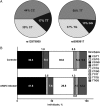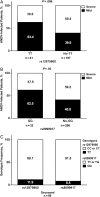Association of Single-Nucleotide Polymorphisms in IL28B, but Not TNF-α, With Severity of Disease Caused by Andes Virus
- PMID: 26394672
- PMCID: PMC4657541
- DOI: 10.1093/cid/civ830
Association of Single-Nucleotide Polymorphisms in IL28B, but Not TNF-α, With Severity of Disease Caused by Andes Virus
Abstract
Background: Andes virus (ANDV) is the sole etiologic agent of hantavirus cardiopulmonary syndrome (HCPS) in Chile, with a fatality rate of about 35%. Individual host factors affecting ANDV infection outcome are poorly understood. In this case-control genetic association analysis, we explored the link between single-nucleotide polymorphisms (SNPs) rs12979860, rs8099917 and rs1800629 and the clinical outcome of ANDV-induced disease. The SNPs rs12979860 and rs8099917 are known to play a role in the differential expression of the interleukin 28B gene (IL28B), whereas SNP rs1800629 is implicated in the expression of tumor necrosis factor α gene (TNF-α).
Methods: A total of 238 samples from confirmed ANDV-infected patients collected between 2006 and 2014, and categorized according to the severity of the disease, were genotyped for SNPs rs12979860, rs8099917, and rs1800629.
Results: Analysis of IL28B SNPs rs12979860 and rs8099917 revealed a link between homozygosity of the minor alleles (TT and GG, respectively), displaying a mild disease progression, whereas heterozygosity or homozygosity for the major alleles (CT/CC and TG/TT, respectively) in both IL28B SNPs is associated with severe disease. No association with the clinical outcome of HCPS was observed for TNF-α SNP rs1800629 (TNF -308G>A).
Conclusions: The IL28B SNPs rs12979860 and rs8099917, but not TNF-α SNP rs1800629, are associated with the clinical outcome of ANDV-induced disease, suggesting a possible link between IL28B expression and ANDV pathogenesis.
Keywords: ANDV; HCPS; IL28B; SNP; TNF-alpha.
© The Author 2015. Published by Oxford University Press on behalf of the Infectious Diseases Society of America. All rights reserved. For Permissions, please e-mail: journals.permissions@oup.com.
Figures



References
-
- Vaheri A, Strandin T, Hepojoki J et al. . Uncovering the mysteries of hantavirus infections. Nat Rev Microbiol 2013; 11:539–50. - PubMed
-
- Padula PJ, Edelstein A, Miguel SD, Lopez NM, Rossi CM, Rabinovich RD. Hantavirus pulmonary syndrome outbreak in Argentina: molecular evidence for person-to-person transmission of Andes virus. Virology 1998; 241:323–30. - PubMed
-
- Macneil A, Nichol ST, Spiropoulou CF. Hantavirus pulmonary syndrome. Virus Res 2011; 162:138–47. - PubMed
Publication types
MeSH terms
Substances
Grants and funding
LinkOut - more resources
Full Text Sources
Other Literature Sources
Medical
Miscellaneous

